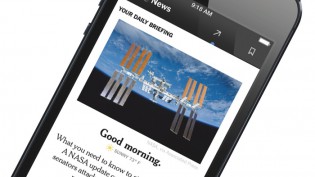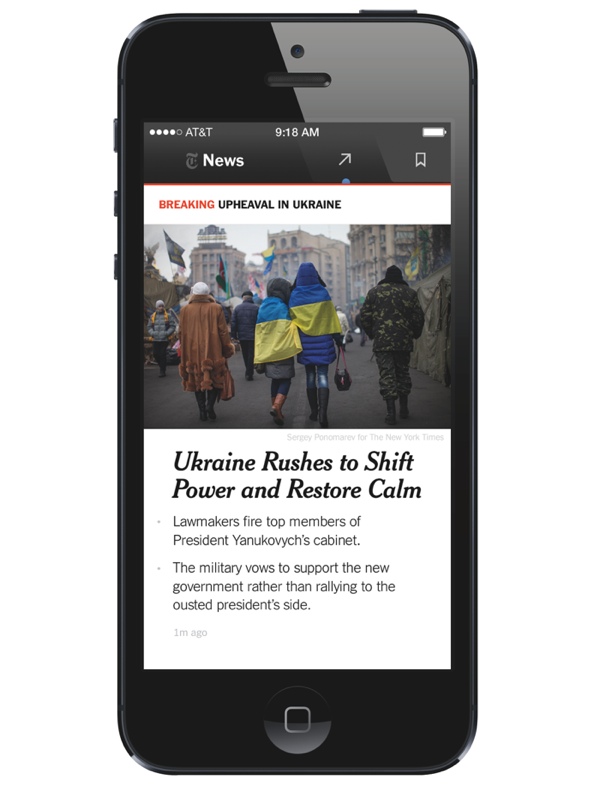Nieman Journalism Lab |
- Talking Points Memo defends its new sponsored content
- It looks like another sports team owner is about to buy another newspaper
- This Week in Review: Reasons for optimism about journalism, and how far to take traffic-chasing
| Talking Points Memo defends its new sponsored content Posted: 28 Mar 2014 02:16 PM PDT
Today, Marshall published a defense of his decision to start publishing sponsored content paid for by PhRMA, the Pharmaceutical Research and Manufacturers of America. Marshall makes the familiar arguments about his intention to retain independence and to clearly label the sponsored content as such, as well as the necessity of revenue to any news organization. But he also makes an interesting case for a reason why an interest group would want to pay for content beyond ultimately duping his reader:
See also Henry Farrell’s complaint at Crooked Timber and Marshall’s response in the comments:
|
| It looks like another sports team owner is about to buy another newspaper Posted: 28 Mar 2014 11:23 AM PDT That’s the report from John Vomhof Jr. of the Minneapolis/St. Paul Business Journal:
I mention this only because it seems to be an increasing trend, and a reversal in local institutional power: Newspapers — once the most profitable, established force in many American cities — seem to be the subject of increasing interest to the owners of major sports teams. Here in Boston, of course, the Globe is now owned by Red Sox owner John Henry. In my home state of Louisiana, New Orleans Saints owner Tom Benson tried (and failed) to buy The Times-Picayune. L.A. Dodgers owner Mark Walter has expressed interest in buying the L.A. Times. I’m sure there are other owners who — sitting on billion-dollar properties and seeing their local daily valued in the tens of millions — have at least thought about flipping over the couch cushions and seeing if they can scrounge up a down payment.
It used to be more common the other way around, media companies buying up or starting sports teams — think Tribune with the Cubs, Turner with the Braves, News Corp. with the Dodgers, Disney with the Mighty Ducks. And that still happens sometimes with broadcast companies or diversified media corporations. Consider this paragraph from a 1999 AJR story and think how foreign that world seems today:
For what it’s worth, the Star Tribune (two Pulitzers last year) has had a better season than the Timberwolves (headed to the lottery and prompting sad videos like this one). Photo of the Timberwolves by Doug Wallick used under a Creative Commons license. |
| This Week in Review: Reasons for optimism about journalism, and how far to take traffic-chasing Posted: 28 Mar 2014 07:21 AM PDT This week’s essential reads: If you only have a minute, the most important reads this week are the overview of Pew’s State of the News Media report, Deadspin’s Tim Marchman on the cynicism of the term clickbait, and the Tow Center’s Alexander Howard putting the data journalism discussion in historical context. Reasons for optimism about the news industry: The Pew Research Journalism Project’s annual smorgasbord of data about the news industry, the State of the News Media report, was released this week, and after several gloomy years, the report had a distinctively optimistic tone this year. The headlining figure, as CNN’s Brian Stelter reported, was Pew’s tally of 5,000 new journalism jobs created at more than 400 digital news startups, in addition to at least $300 million in venture capital into news-related digital media startups in 2013. Pew’s president, Alan Murray, provided several reasons for optimism from the report, including its findings of increasing news consumption on mobile devices and social media, and Pete Cashmore of Mashable praised the growing efforts to make news more accessible and mobile. USA Today’s Rem Rieder also expressed his enthusiasm for journalism’s online growth, though he expressed concern about the future of local journalism. The Knight Foundation’s Eric Newton said student journalists are a big part of the new work that’s being done in local journalism and shouldn’t be left out of studies like this. The Washington Post’s Paul Farhi went deeper into local journalism’s long decline, pointing out that “the biggest investments in digital news have gone toward start-up ventures that target broad and borderless audiences, bypassing community news altogether.” There was plenty of bad news in the report, too, and Digiday’s Lucia Moses gave an overview of some of it: The new revenue is only a sliver of journalism’s total funding, which still remains heavily dependent on advertising. And the 5,000 new jobs are a long way from replacing the jobs that have been lost. Poynter’s Rick Edmonds noted that despite its decline, the newspaper industry still accounts for more than half of the news business’ revenues. TV news — whether local, cable, or network — earns far less revenue, as Edmonds pointed out. Pew’s numbers were particularly dire for MSNBC, as Erik Wemple of The Washington Post and Dylan Byers of Politico pointed out. The Lab’s Justin Ellis highlighted the year of ownership upheaval in the local TV news industry, as well as the growth of online video. Poynter’s Sam Kirkland noted that that growth isn’t as great as one might expect, though the audience for online news videos is remarkably young. And Patrick Seitz of Investor’s Business Daily detailed the role of Facebook in young people’s news consumption habits.
Debating the merits of chasing traffic: The move toward a more nakedly traffic-driven orientation has been in the works in online news for a long time, but the Advance-owned Oregonian in Portland may have taken it to new levels among traditional news organizations. The alt-weekly Willamette Week reported on internal documents at the paper that require Oregonian reporters to post new articles three times a day and post the first comment on any substantial post. Annual bonuses will be based on performance ratings, which will be determined in large part on web metrics. The Columbia Journalism Review’s Ryan Chittum decried the move as a brazen institutionalization of the “hamster wheel” mentality that has overtaken journalism, saying it makes it much more difficult for The Oregonian’s reporters to do good, serious work. “The sad thing about Advance's digital forced march is that its executives really think they're getting ahead of the curve. But they're implementing 2008's conventional wisdom in 2014, and they're doing it badly at that,” Chittum wrote. Mathew Ingram of Gigaom agreed that the plan is too pageview-focused and likely to lead to clickbait, but said he liked the focus on engagement, producing lots of regular content, and a variety of posting styles. The Lab’s Joshua Benton said he’s not so much concerned about the particulars of The Oregonian’s bet on online traffic as the fact that it’s making a bet in the first place. Any bet, he said, is an encouraging departure from the age-old plan of cutting, retrenching around declining print advertising and circulation, and relying on an aging audience. The New York Times’ David Carr included The Oregonian’s changes as an example of a larger trend toward paying journalists based on the traffic they bring in, a practice that brings a welcome meritocracy to journalistic production but is also alarmingly open to manipulation. Newswhip’s Paul Quigley argued that this trend actually tilts things toward writers’ favor rather than their bosses, because it depends in part on their brands and their networks. Gigaom’s Ingram noted, though, that this obsession will continue as long as advertising (and, by extension, advertisers) are still driving the bus of online revenue. Lucia Moses of Digiday looked at the range of approaches among online news organizations to giving journalists metrics, and Poynter’s Sam Kirkland noted that there are still lines editors won’t cross in search of traffic. Deadspin’s Tim Marchman railed against the cynicism in the ubiquitous term clickbait, saying it presents a moralistic “false binary between stories that serve the public interest and those cynically presented just because people will read them.”
Facebook jumps into virtual reality: Facebook made another big-dollar, out-of-left-field purchase this week, buying two-year-old startup Oculus Rift, which makes virtual reality headgear, for $2 billion. Recode’s Kara Swisher reported some details on how the deal came together, and Time’s Lev Grossman wrote a good profile on Oculus’ background and what sets it apart. Virtual reality, of course, wouldn’t seem to be a natural extension of Facebook’s existing platform, so many people have been wondering exactly what the social network has in mind. Facebook’s Mark Zuckerberg said he plans to start with Oculus’ current ambitions in gaming and then move toward providing a broader range of virtual experiences with friends. Andrew Wallenstein of Variety said, though, that Facebook’s eventually going to end up in the movie business. Several other observers said Zuckerberg doesn’t really know what Facebook’s going to do with Oculus; he’s simply hedging his bets on the technology of the future. Said venture capitalist Fred Wilson: “The next thing was mobile. Mobile is now the last thing. And all of these big tech companies are looking for the next thing to make sure they don't miss it.” Reuters’ Felix Salmon compared Zuckerberg to Warren Buffett, hedging his bets in all kinds of fields against the eventual decline of Facebook as a social media platform. Gigaom founder Om Malik said the interesting realization in all this “billion dollar dart throwing” is that we’re moving toward a glass ceiling for the advertising-based model. Forbes’ Eric Mack argued, meanwhile, that Zuckerberg will have a tough time turning virtual reality into a mainstream technology. Oculus raised its initial $2.4 million through Kickstarter, and its backers there were not exhilarated at the company’s big payday, but outraged, as The Verge’s Adrianne Jeffries reported. Minecraft creator Markus Persson said he would no longer work with Oculus, and Dean Putney of BoingBoing captured the disappointment of people who thought Oculus could be a “next big thing” that was actually powered by the grassroots, rather than corporations. PandoDaily’s James Robinson said virtual reality just became a monopoly, and other new technologies are likely to follow: “An entire generation of hardware innovation is up for grabs right now, and neither Facebook or Google seem about to close their wallets.” Net neutrality and streaming video: The net neutrality debate was stoked again late last week by a pair of posts from two of the players with the biggest stakes in the game. Netflix’s Reed Hastings made the argument for stronger net neutrality, saying that Internet service providers are charging content providers for interconnection (like in the deal Netflix made with Comcast last month) just because they can. AT&T’s Jim Cicconi countered that users’ increasing appetite for streaming video (that is, Netflix) has huge costs for ISPs, and that Netflix wants those costs to be borne by all broadband customers, rather than the ones who are streaming the video through Netflix. Supporters fell in on both sides: BoingBoing’s Cory Doctorow called AT&T’s policies “extortion,” and the New America Foundation’s Sarah Morris called for strong net neutrality to police the opaque world of interconnection in which the Netflixes and AT&Ts of the world negotiate. On the other side, StreamingMedia’s Dan Rayburn said Netflix isn’t being straightforward about the situation it’s actually in, and Forbes’ Mark Rogowsky said the net neutrality Netflix is calling for wouldn’t solve its problems. The Verge’s Ben Popper explained Netflix’s deal with Comcast in light of Hastings’ post, and Gigaom’s Janko Roettgers looked at whether Hastings’ tongue-in-cheek proposal that Netflix should become a peer-to-peer network would actually work. Meanwhile, The Wall Street Journal reported that Apple and Comcast are in talks about a deal that would use an Apple set-top box for streaming TV and allow Apple to bypass online data congestion through an interconnectivity arrangement. There was a lot of skepticism about the story, with Variety’s Andrew Wallenstein, Gigaom’s Janko Roettgers, and StreamingMedia’s Dan Rayburn all throwing cold water on it. Reading roundup: Several other noteworthy stories from this busy week: — After weeks of hints, The New York Times officially announced two new paid-content options, an $8-a-month app of core Times content called NYT Now and a $45-a-month subscription called Times Premier that includes behind-the-scenes information about the paper. Poynter’s Sam Kirkland has more details on the programs, BuzzFeed’s Charlie Warzel looked at whether NYT Now will succeed, and Gigaom’s Mathew Ingram offered suggestions for personalizing the Times’ paid content plans. — Turkey’s government sought to ban Twitter late last week, prompting widespread workarounds by Turkish Twitter users as well as a legal challenge filed by Twitter. One Turkish court overturned the ban on Wednesday, while another one rejected Twitter’s complaint. The government also blocked YouTube on Thursday. Some of the best commentary on the subject has been by Turkish digital sociology professor Zeynep Tufekci, who explained why Turkey is blocking Twitter and what Turks are doing about it. — The chatter about Nate Silver’s relaunched data journalism site FiveThirtyEight continued this week, and while much of it come from an ongoing slap-fight between Silver and New York Times columnist Paul Krugman, some of it was also quite thought-provoking. The Tow Center’s Alexander Howard gave some historical context to some of the backlash against data journalism, Om Malik gave some advice to Silver on dealing with criticism, the Columbia Journalism Review’s Tanveer Ali called for better understanding of narrative at FiveThirtyEight, and Adam Tinworth offered a defense of data journalism. — The New York Times reported that the Obama administration is proposing an end to the U.S. National Security Agency’s systematic collection of Americans’ bulk phone records, allowing it access to phone companies’ data only with a specific court order. The Volokh Conspiracy’s Stewart Baker compared Obama’s plan to Congress’ proposed overhaul, and The Intercept’s Glenn Greenwald examined the tough spot the new plan may put pro-NSA Democrats in. — Finally, tech blogger Ben Thompson wrote a thoughtful post on the well-trod topic of traditional and future business models for news, and the Lab’s Joshua Benton added some of his thoughts on what might be ahead. Photos of Bangkok traffic by Joan Campderrós-i-Canas and Oculus Rift by Sergey Galyonkin used under a Creative Commons license. |
| You are subscribed to email updates from Nieman Journalism Lab To stop receiving these emails, you may unsubscribe now. | Email delivery powered by Google |
| Google Inc., 20 West Kinzie, Chicago IL USA 60610 | |






















 Jeff Bezos (right) may be the most prominent rich person to buy into the newspaper industry recently, but he’s not the only one.
Jeff Bezos (right) may be the most prominent rich person to buy into the newspaper industry recently, but he’s not the only one.